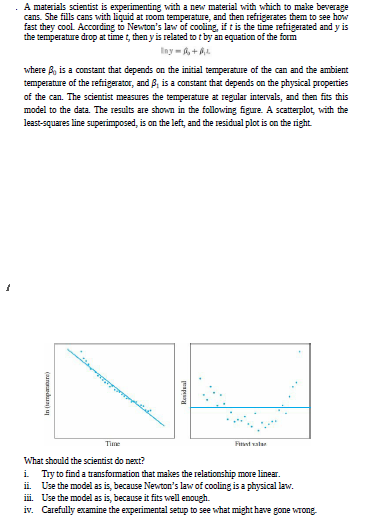A materials scientist is experimenting with a new material with which to make beverage cans. She fills cans with liquid at room temperature, and then refrigerates them to see how fast they cool According to Newton's law of cooling, if t is the time refrigerated and y is the temperature drop at time t, then y is related to t by an equation of the form Iny-,+L where B, is a constant that depends on the initial temperature of the can and the ambient temperature of the refigerator, and B, is a constant that depends on the physical properties of the can. The scientist measures the temperature at regular intervals, and then fits this model to the data. The results are shown in the following figure. A scatterplot, with the least-squares line superimposed, is on the left, and the residual plot is on the right Time Fit vala What should the scientist do next? Try to find a transfomation that makes the relationship more linear. ii. Use the model as is, because Newton's law of cooling is a physical law. ii. Use the model as is, because it fits well enough. iv. Carefully examine the experimental setup to see what might have gone wrong. In empanure) Residual
A materials scientist is experimenting with a new material with which to make beverage cans. She fills cans with liquid at room temperature, and then refrigerates them to see how fast they cool According to Newton's law of cooling, if t is the time refrigerated and y is the temperature drop at time t, then y is related to t by an equation of the form Iny-,+L where B, is a constant that depends on the initial temperature of the can and the ambient temperature of the refigerator, and B, is a constant that depends on the physical properties of the can. The scientist measures the temperature at regular intervals, and then fits this model to the data. The results are shown in the following figure. A scatterplot, with the least-squares line superimposed, is on the left, and the residual plot is on the right Time Fit vala What should the scientist do next? Try to find a transfomation that makes the relationship more linear. ii. Use the model as is, because Newton's law of cooling is a physical law. ii. Use the model as is, because it fits well enough. iv. Carefully examine the experimental setup to see what might have gone wrong. In empanure) Residual
Algebra & Trigonometry with Analytic Geometry
13th Edition
ISBN:9781133382119
Author:Swokowski
Publisher:Swokowski
Chapter5: Inverse, Exponential, And Logarithmic Functions
Section5.6: Exponential And Logarithmic Equations
Problem 64E
Related questions
Question

Transcribed Image Text:A materials scientist is experimenting with a new material with which to make beverage
cans. She fills cans with liquid at room temperature, and then refrigerates them to see how
fast they cool According to Newton's law of cooling, if t is the time refrigerated and y is
the temperature drop at time t, then y is related to t by an equation of the form
Iny-,+L
where B, is a constant that depends on the initial temperature of the can and the ambient
temperature of the refigerator, and B, is a constant that depends on the physical properties
of the can. The scientist measures the temperature at regular intervals, and then fits this
model to the data. The results are shown in the following figure. A scatterplot, with the
least-squares line superimposed, is on the left, and the residual plot is on the right
Time
Fit vala
What should the scientist do next?
Try to find a transfomation that makes the relationship more linear.
ii. Use the model as is, because Newton's law of cooling is a physical law.
ii. Use the model as is, because it fits well enough.
iv. Carefully examine the experimental setup to see what might have gone wrong.
In empanure)
Residual
Expert Solution
This question has been solved!
Explore an expertly crafted, step-by-step solution for a thorough understanding of key concepts.
This is a popular solution!
Trending now
This is a popular solution!
Step by step
Solved in 2 steps

Recommended textbooks for you

Algebra & Trigonometry with Analytic Geometry
Algebra
ISBN:
9781133382119
Author:
Swokowski
Publisher:
Cengage

College Algebra
Algebra
ISBN:
9781305115545
Author:
James Stewart, Lothar Redlin, Saleem Watson
Publisher:
Cengage Learning

Algebra & Trigonometry with Analytic Geometry
Algebra
ISBN:
9781133382119
Author:
Swokowski
Publisher:
Cengage

College Algebra
Algebra
ISBN:
9781305115545
Author:
James Stewart, Lothar Redlin, Saleem Watson
Publisher:
Cengage Learning